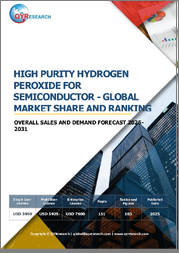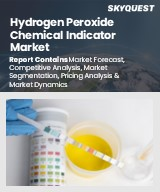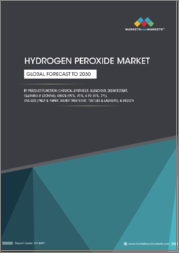
|
시장보고서
상품코드
1661010
세계의 과산화수소 시장 보고서 : 용도, 최종 용도, 지역별(2025-2033년)Hydrogen Peroxide Market Report by Application, End-Use, and Region 2025-2033 |
||||||
세계의 과산화수소 시장 규모는 2024년 35억 달러에 달했습니다. 앞으로 IMARC Group은 시장이 2033년까지 46억 달러에 이르며, 2025년부터 2033년까지 3.15%의 성장률(CAGR)을 나타낼 것으로 예측했습니다. 지카바이러스, 뎅기열, 말라리아 등의 매개성 질환의 발생 증가, 식음료 가공 기기 수요 증가, 신형 스마트폰 출시 등이 시장에 긍정적인 영향을 미치고 있습니다.
다양한 의료 목적의 용도 확대가 시장 성장을 가속
가벼운 상처, 찰과상, 열상 감염 예방에 사용되는 온화한 소독제로서의 과산화수소 수요 증가는 시장에 긍정적인 영향을 미칩니다. 과산화수소는 점액을 제거하거나 구각염과 냉증, 치은염으로 인한 입안의 가벼운 염증을 완화시키는 세구액으로도 사용됩니다. 이 제품은 환부에 바르면 산소를 방출하고 발포하고 오래된 각질을 제거하여 환부를 청결하게합니다. 또한 휘발성으로 인해 상처 치유를 돕고 급속한 산화를 유발합니다. 이 외에도 과산화수소는 후천성 면역결핍 증후군(AIDS), 암, 인플루엔자, 폐기종 치료 등 의료 용도에도 사용됩니다.
시장 구조, 주요 기업의 시장 점유율, 주요 기업 시장 상황 분석, 주요 성공 전략, 경쟁 대시보드, 기업 평가 사분면 등의 경쟁 분석이 본 보고서에서 다룹니다. 또한 주요 기업의 상세 프로파일도 제공합니다. 시장 구조는 세분화되어 있으며 많은 기업이 업계에서 활동하고 있습니다. 과산화수소 산업에서는 최종 이용 산업에서 수요 증가와 제품 차별화가 낮기 때문에 신규 진입의 양은 완만합니다. 그러나 높은 자본 투자와 엄격한 규제 프레임워크은 새로운 진입을 막고 있습니다.
과산화수소란?
과산화수소(H2O2)는 담청색의 화합물로 투명한 액체이며 물에 비해 점성이 높습니다. 성질이 불안정하기 때문에 일반적으로 안정제와 함께 약산성 용액으로 보존됩니다. 강한 산화 작용이 있기 때문에 강력한 표백제가 되어 주로 종이 표백에 사용됩니다. 과산화 카르바미드의 형태인 H2O2도 전문가나 스스로 하는 치아 미백에 응용되고 있습니다. 또한 인체의 숙주 방어와 산화적 생합성 반응에서도 중요한 역할을 하고 있습니다. 살균제나 산화제로 사용되기 때문에 H2O2는 세계 제지 및 펄프, 화학, 의약품, 퍼스널케어 및 화장품, 일렉트로닉스, 농업 산업에서 응용되고 있습니다.
COVID-19의 영향:
COVID-19 팬데믹의 발생은 과산화수소 산업에 심각한 문제를 일으키고 많은 국가에 전례없는 과제를 부과했습니다. 세계 봉쇄 및 정부의 지시에 따라 많은 화학 생산 공장은 제조 업무를 감속 시켰습니다. 이 업계는 생산노동자의 대부분이 원격조작이 불가능한 현장작업에 종사했기 때문에 취약했습니다. 게다가 가동하고 있는 공장은 거의 없고, 원료 업계로부터 공급 장애, 노동력 부족, 적은 재고가 부담이 되고 있었습니다. 이 외에도 운송 및 산업 생산 제한이 공급망에 영향을 미칩니다. 또한 물류 문제, 인력 부족, 운전자 부족, 도로 봉쇄로 인해 기업은 생산을 지연 시켰습니다. 이러한 요인들은 유행 중에 과산화수소 산업의 성장을 둔화시켰습니다.
과산화수소 시장 동향 :
현재, 표백 공정에서 염소 화합물을 제거하기 위한 표백 제품에서 H2O2 수요가 증가하고 있습니다. 이는 일부 수처리 용도에서 산화제로서 H2O2의 이용이 증가함에 따라 시장 성장을 지원하는 주요 요인 중 하나가 되었습니다. 또한 세계 펄프 및 제지 업계에서는 친환경 표백제로 H2O2 수요가 증가하고 있습니다. 이것은 H2O2의 장점에 대한 대중의 의식이 증가함에 따라 시장 성장을 가속합니다. 게다가 공해방지 용도를 위해 각국 정부가 하고 있는 몇 가지 대처가 시장의 성장을 강화하고 있습니다. 이와는 별도로, 프로파일렌 옥사이드(HPPO)를 제조하기 위한 H2O2 기술의 채용이 증가하고 있어 시장 전망이 양호합니다. 이에 따라, 안전하고 위생적인 포장을 제조하기 위한 식품/음식(F&B) 산업에서의 H2O2 수요 증가는 업계 투자자들에게 유리한 성장 기회를 제공합니다. 또한, 농작물의 수확량을 높이기 위한 농업업계에서의 H2O2 수요 증가는 시장의 성장을 가속하고 있습니다. 게다가 박테리아, 효모, 곰팡이, 바이러스, 포포 등 폭넓은 미생물에 대한 소독제로서 H2O2 수요가 증가하고 있는 것이 시장의 성장을 뒷받침하고 있습니다.
이 보고서에서 다루는 주요 질문
- 세계 과산화수소 시장 규모는?
- 2025-2033년 세계 과산화수소 시장의 예상 성장률은?
- 세계 과산화수소 시장을 견인하는 주요 요인은?
- 세계 과산화수소 시장에 대한 COVID-19의 영향은?
- 세계 과산화수소 시장의 용도별 내역은?
- 세계 과산화수소 시장의 용도별 내역은?
- 세계 과산화수소 시장의 주요 지역은?
- 세계 과산화수소 시장에서 주요 기업은?
목차
제1장 서문
제2장 조사 범위와 조사 방법
- 조사의 목적
- 이해관계자
- 데이터 소스
- 1차 정보
- 2차 정보
- 시장 추정
- 상향식 접근
- 하향식 접근
- 조사 방법
제3장 주요 요약
제4장 소개
- 개요
- 속성
- 주요 업계 동향
제5장 세계의 과산화수소 시장
- 시장 개요
- 시장 실적
- COVID-19의 영향
- 시장 분석 : 용도별
- 시장 내역 : 최종 용도별
- 시장 분석 : 지역별
- 시장 예측
- SWOT 분석
- 개요
- 강점
- 약점
- 기회
- 위협
- 밸류체인 분석
- 개요
- 연구개발
- 원재료 조달
- 제조
- 마케팅
- 유통
- 최종 용도
- Porter's Five Forces 분석
- 개요
- 구매자의 협상력
- 공급기업의 협상력
- 경쟁도
- 신규 참가업체의 위협
- 대체품의 위협
- 가격 분석
- 주요 가격 지표
- 가격구조
- 마진 분석
제6장 시장 분석 : 용도별
- 화학합성
- 시장 동향
- 시장 예측
- 표백
- 시장 동향
- 시장 예측
- 소독제
- 시장 동향
- 시장 예측
- 세정과 에칭
- 시장 동향
- 시장 예측
- 기타
- 시장 동향
- 시장 예측
제7장 시장 내역: 최종 용도별
- 펄프 및 종이
- 시장 동향
- 시장 예측
- 음식
- 시장 동향
- 시장 예측
- 수처리
- 시장 동향
- 시장 예측
- 텍스타일 및 세탁
- 시장 동향
- 시장 예측
- 석유 및 가스
- 시장 동향
- 시장 예측
- 헬스케어
- 시장 동향
- 시장 예측
- 일렉트로닉스
- 시장 동향
- 시장 예측
- 기타
- 시장 동향
- 시장 예측
제8장 시장 분석 : 지역별
- 아시아태평양
- 시장 동향
- 시장 예측
- 유럽
- 시장 동향
- 시장 예측
- 중동 및 아프리카
- 시장 동향
- 시장 예측
- 북미
- 시장 동향
- 시장 예측
- 라틴아메리카
- 시장 동향
- 시장 예측
제9장 수입과 수출
- 수입 : 주요 국가별
- 수출 : 주요 국가별
제10장 과산화수소 제조 공정
- 제품 개요
- 원재료 요건
- 제조 공정
- 주요 성공 요인과 위험 요인
제11장 경쟁 구도
- 시장 구조
- 주요 기업
- 주요 기업 프로파일
- Solvay
- Evonik
- Arkema
- Kemira Oyj
- FMC Corporation
- EkO Peroxide LLC(acquired: by AkzoNobel)
- Mitsubishi Gas Chemical Company
- PeroxyChem LLC
- Aditya Birla Chemicals Limited
- Kingboard Chemical Holdings Ltd
- BASF SE
- Merck
- Chang Chun Petrochemical
- Guangdong Zhongcheng Chemicals
- Hansol Chemical
The global hydrogen peroxide market size reached USD 3.5 Billion in 2024. Looking forward, IMARC Group expects the market to reach USD 4.6 Billion by 2033, exhibiting a growth rate (CAGR) of 3.15% during 2025-2033. The growing occurrence of vector-borne diseases like Zika virus, dengue, and malaria, rising demand for food and beverage processing equipment, and launch of new smartphones are positively influencing the market.
Rising Application in Various Medical Purposes Propelling Market Growth
The growing demand for hydrogen peroxide as a mild antiseptic used to prevent infection of minor cuts, scrapes, and burns is positively influencing the market. It may also be used as a mouth rinse to help remove mucus or to relieve minor mouth irritation due to canker or cold sores and gingivitis. This product works by releasing oxygen when it is applied to the affected area and causes foaming, which helps remove dead skin and clean the area. It also aids in healing wounds due to its volatile nature, which causes rapid oxidation. Apart from this, hydrogen peroxide is used in medical applications, such as treating acquired immune deficiency syndrome (AIDS), cancer, influenza, and emphysema.
Competitive analysis such as market structure, market share by key players, player positioning, top winning strategies, competitive dashboard, and company evaluation quadrant has been covered in the report. Also, detailed profiles of all major companies have been provided. The market structure is fragmented with large number of players operating in the industry. The volume of new entrants is moderate in the hydrogen peroxide industry due to rising demand from end use industry and low product differentiation. However, high capital investment and strict regulatory framework prevent new players to enter the business.
What is Hydrogen Peroxide?
Hydrogen peroxide (H2O2) is a pale blue chemical compound with clear liquid, which is more viscous as compared to water. It is unstable in nature, due to which it is usually stored in a weak acidic solution with a stabilizer. It has strong oxidizing properties, thereby making it a powerful bleaching agent, which is largely used for bleaching paper. H2O2 in the form of carbamide peroxide also has applications for tooth whitening in professionally and self-administered products. In addition, it plays important roles in host defense and oxidative biosynthetic reactions in the human body. As it is used as a disinfectant and as an oxidizer, H2O2 finds applications in the paper and pulp, chemical, pharmaceutical, personal care and cosmetics, electronics, and agriculture industries across the globe.
COVID-19 Impact:
The COVID-19 pandemic outbreak has caused a severe problem for the hydrogen peroxide industry and imposed unprecedented challenges on numerous countries. Owing to the global lockdowns and in compliance with directives from the government, many chemical production plants have slowed down their manufacturing operations. The industry was vulnerable, given that the bulk of its production workforce was in on-site jobs that could not be done remotely. Moreover, few running plants were burdened with supply disruptions from the raw materials industry, labor shortages, and low stocks. Besides this, restrictions on shipping and industrial production have affected the supply chain. In addition, companies have slowed down production due to logistics issues, staffing shortages, lack of drivers, and roadblocks. These factors have slowed down the growth of the hydrogen peroxide industry during the pandemic.
Hydrogen Peroxide Market Trends:
At present, there is a rise in the demand for H2O2 in bleach products for removing chlorine compounds through bleaching processes. This, along with the increasing utilization of H2O2 as an oxidizing agent for several water treatment applications, represents one of the key factors supporting the growth of the market. In addition, there is an increase in the demand for H2O2 as environment-friendly bleaching agents in the pulp and paper industry across the globe. This, coupled with the rising awareness among the masses about the benefits of H2O2, is propelling the growth of the market. Moreover, several initiatives undertaken by governments of various countries for pollution control applications are strengthening the growth of the market. Apart from this, the growing employment of H2O2 to produce propylene oxide (HPPO) technology is offering a favorable market outlook. In line with this, the escalating demand for H2O2 in the food and beverage (F&B) industry to manufacture safe and hygienic packaging is providing lucrative growth opportunities to industry investors. Additionally, the rising demand for H2O2 in the agriculture industry to improve crop yield is impelling the growth of the market. Furthermore, the increasing demand for H2O2 as a disinfectant against a wide range of microorganisms, such as bacteria, yeasts, fungi, viruses, and spores, is bolstering the growth of the market.
Key Market Segmentation:
Application Insights:
- Chemical Synthesis
- Bleaching
- Disinfectant
- Cleaning and Etching
- Others
End-Use Insights:
- Pulp and Paper
- Food and Beverages
- Water Treatment
- Textiles and Laundry
- Oil and Gas
- Healthcare
- Electronics
- Others
Regional Insights:
- Asia Pacific
- Europe
- Middle East and Africa
- North America
- Latin America
- The report has also provided a comprehensive analysis of all the major regional markets, which include Asia Pacific, Europe, the Middle East and Africa, North America, and Latin America. According to the report, Asia Pacific was the largest market for hydrogen peroxide. Some of the factors driving the Asia Pacific hydrogen peroxide market included the increasing utilization of hydrogen peroxide in disinfectants and developing pulp and paper industry. Apart from this, various applications of hydrogen peroxide in the food and beverage (F&B), processing, textiles, chemical, and oil and gas industries are strengthening the growth of the market in the region.
Competitive Landscape:
The report has also provided a comprehensive analysis of the competitive landscape in the global hydrogen peroxide market. Some of the companies covered in the report include:
- Solvay
- Evonik
- Arkema
- Kemira Oyj
- FMC Corporation
- EkO Peroxide LLC (acquired by AkzoNobel)
- Mitsubishi Gas Chemical Company
- PeroxyChem LLC
- Aditya Birla Chemicals Limited
- Kingboard Chemical Holdings Ltd
- BASF SE
- Merck
- Chang Chun Petrochemical
- Guangdong Zhongcheng Chemicals
- Hansol Chemical
Key Questions Answered in This Report
- 1.How big is the global hydrogen peroxide market?
- 2.What is the expected growth rate of the global hydrogen peroxide market during 2025-2033?
- 3.What are the key factors driving the global hydrogen peroxide market?
- 4.What has been the impact of COVID-19 on the global hydrogen peroxide market?
- 5.What is the breakup of the global hydrogen peroxide market based on the application?
- 6.What is the breakup of the global hydrogen peroxide market based on the end-use?
- 7.What are the key regions in the global hydrogen peroxide market?
- 8.Who are the key players/companies in the global hydrogen peroxide market?
Table of Contents
1 Preface
2 Scope and Methodology
- 2.1 Objectives of the Study
- 2.2 Stakeholders
- 2.3 Data Sources
- 2.3.1 Primary Sources
- 2.3.2 Secondary Sources
- 2.4 Market Estimation
- 2.4.1 Bottom-Up Approach
- 2.4.2 Top-Down Approach
- 2.5 Forecasting Methodology
3 Executive Summary
4 Introduction
- 4.1 Overview
- 4.2 Properties
- 4.3 Key Industry Trends
5 Global Hydrogen Peroxide Market
- 5.1 Market Overview
- 5.2 Market Performance
- 5.3 Impact of COVID-19
- 5.4 Market Breakup by Application
- 5.5 Market Breakup by End-Use
- 5.6 Market Breakup by Region
- 5.7 Market Forecast
- 5.8 SWOT Analysis
- 5.8.1 Overview
- 5.8.2 Strengths
- 5.8.3 Weaknesses
- 5.8.4 Opportunities
- 5.8.5 Threats
- 5.9 Value Chain Analysis
- 5.9.1 Overview
- 5.9.2 Research and Development
- 5.9.3 Raw Material Procurement
- 5.9.4 Manufacturing
- 5.9.5 Marketing
- 5.9.6 Distribution
- 5.9.7 End-Use
- 5.10 Porters Five Forces Analysis
- 5.10.1 Overview
- 5.10.2 Bargaining Power of Buyers
- 5.10.3 Bargaining Power of Suppliers
- 5.10.4 Degree of Competition
- 5.10.5 Threat of New Entrants
- 5.10.6 Threat of Substitutes
- 5.11 Price Analysis
- 5.11.1 Key Price Indicators
- 5.11.2 Price Structure
- 5.11.3 Margin Analysis
6 Market Breakup by Application
- 6.1 Chemical Synthesis
- 6.1.1 Market Trends
- 6.1.2 Market Forecast
- 6.2 Bleaching
- 6.2.1 Market Trends
- 6.2.2 Market Forecast
- 6.3 Disinfectant
- 6.3.1 Market Trends
- 6.3.2 Market Forecast
- 6.4 Cleaning and Etching
- 6.4.1 Market Trends
- 6.4.2 Market Forecast
- 6.5 Others
- 6.5.1 Market Trends
- 6.5.2 Market Forecast
7 Market Breakup by End-Use
- 7.1 Pulp and Paper
- 7.1.1 Market Trends
- 7.1.2 Market Forecast
- 7.2 Food and Beverages
- 7.2.1 Market Trends
- 7.2.2 Market Forecast
- 7.3 Water Treatment
- 7.3.1 Market Trends
- 7.3.2 Market Forecast
- 7.4 Textiles and Laundry
- 7.4.1 Market Trends
- 7.4.2 Market Forecast
- 7.5 Oil and Gas
- 7.5.1 Market Trends
- 7.5.2 Market Forecast
- 7.6 Healthcare
- 7.6.1 Market Trends
- 7.6.2 Market Forecast
- 7.7 Electronics
- 7.7.1 Market Trends
- 7.7.2 Market Forecast
- 7.8 Others
- 7.8.1 Market Trends
- 7.8.2 Market Forecast
8 Market Breakup by Region
- 8.1 Asia Pacific
- 8.1.1 Market Trends
- 8.1.2 Market Forecast
- 8.2 Europe
- 8.2.1 Market Trends
- 8.2.2 Market Forecast
- 8.3 Middle East and Africa
- 8.3.1 Market Trends
- 8.3.2 Market Forecast
- 8.4 North America
- 8.4.1 Market Trends
- 8.4.2 Market Forecast
- 8.5 Latin America
- 8.5.1 Market Trends
- 8.5.2 Market Forecast
9 Imports and Exports
- 9.1 Imports by Major Countries
- 9.2 Exports by Major Countries
10 Hydrogen Peroxide Manufacturing Process
- 10.1 Product Overview
- 10.2 Raw Material Requirements
- 10.3 Manufacturing Process
- 10.4 Key Success and Risk Factors
11 Competitive Landscape
- 11.1 Market Structure
- 11.2 Key Players
- 11.3 Profiles of Key Players
- 11.3.1 Solvay
- 11.3.2 Evonik
- 11.3.3 Arkema
- 11.3.4 Kemira Oyj
- 11.3.5 FMC Corporation
- 11.3.6 EkO Peroxide LLC (acquired by AkzoNobel)
- 11.3.7 Mitsubishi Gas Chemical Company
- 11.3.8 PeroxyChem LLC
- 11.3.9 Aditya Birla Chemicals Limited
- 11.3.10 Kingboard Chemical Holdings Ltd
- 11.3.11 BASF SE
- 11.3.12 Merck
- 11.3.13 Chang Chun Petrochemical
- 11.3.14 Guangdong Zhongcheng Chemicals
- 11.3.15 Hansol Chemical



















